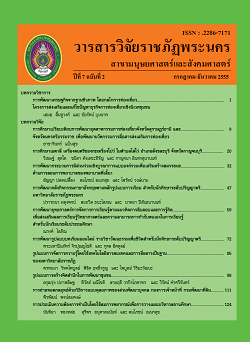รูปแบบการสร้างจิตสำนึกในการพัฒนาชุมชน
Main Article Content
Abstract
การวิจัยครั้งนี้ มีวัตถุประสงค์เพื่อ 1. ศึกษาแนวคิดเชิงทฤษฎีที่เกี่ยวกับจิตสำนึกในการพัฒนาชุมชน 2. ศึกษาบริบทของชุมชนที่เกี่ยวกับจิตสำนึกในการพัฒนาชุมชน 3. พัฒนารูปแบบการสร้างจิตสำนึกในการ พัฒนาชุมชน และ 4. ศึกษาผลการใช้รูปแบบการสร้างจิตสำนึกในการพัฒนาชุมชน โดยประยุกต์ใช้ระเบียบวิธี วิจัยแบบผสมผสาน (Mixed Methods) ได้แก่ การวิจัยเชิงคุณภาพ เพื่อวิเคราะห์สาระจากเอกสาร ตำรา บทความและงานวิจัย ที่เกี่ยวข้อง กับการพัฒนารูปแบบการสร้างจิตสำนึกในการพัฒนาชุมชน และการศึกษา วิจัยภาคสนาม วิเคราะห์สาระจากการสนทนากลุ่ม การสัมภาษณ์ การสัมภาษณ์แบบเจาะลึก และการสังเกต ปรากฏการณ์ในชุมชน และการวิจัยเชิงปริมาณ เพื่อวิเคราะห์ข้อมูลที่แสดงเป็นตัวเลข และสถิติ ได้แก่ ร้อยละ ค่าเฉลี่ย ค่าเบี่ยงเบนมาตรฐาน กลุ่มตัวอย่าง ได้แก่ ผู้นำชุมชน ใช้วิธีการเลือกแบบเจาะจง จำนวน 20 คน และตัวแทนชาวบ้านในชุมชน ที่อาศัยอยู่ในชุมชนมาไม่น้อยกว่า 6 เดือน นับจากวันที่ผู้วิจัยลงพื้นที่ จำนวน 254 คน เครื่องมือที่ใช้ในการวิจัย ได้แก่ รูปแบบการสร้างจิตสำนึกในการพัฒนาชุมชน แบบสัมภาษณ์ แบบสอบถาม แบบสำรวจชุมชน แบบวัดเจตคติ
ผลการวิจัย มีดังนี้ สภาพที่เป็นลักษณะของการมีจิตสำนึกในการพัฒนาชุมชน มี 3 ลักษณะ คือ ลักษณะที่ 1 การไม่กระทำสิ่งที่ก่อให้เกิดปัญหาแก่ส่วนรวมขึ้นในชุมชน ลักษณะที่ 2 การมีส่วนร่วมในกิจกรรม เพื่อการพัฒนาชุมชน ลักษณะที่ 3 การมีนํ้าใจเอื้ออาทรต่อกัน เมื่อพิจารณาความเป็นระบบและความเหมาะ สมของรูปแบบ พบว่า ทุกประเด็น มีความเหมาะสม และมีความเป็นไปได้ที่จะนำไปใช้ในการสร้างจิตสำนึกใน การพัฒนาชุมชน หลังการทดลองใช้รูปแบบ ชาวบ้านในชุมชนมีจิตสำนึกในการพัฒนาชุมชนเพิ่มขึ้น และภาพรวม การใช้รูปแบบ มีความเหมาะสมระดับมาก ผู้ใช้มีความพึงพอใจต่อรูปแบบ ในระดับมากที่สุด เมื่อวัดระดับ จิตสำนึกในการพัฒนาชุมชน พบว่า กลุ่มตัวอย่าง มีระดับจิตสำนึกในระดับค่อนข้างมากขึ้นไป สูงถึงร้อยละ 83.7 ซึ่งสูงกว่าเกณฑ์ที่ผู้วิจัยกำหนดไว้ คือ ร้อยละ 80 ถือว่ารูปแบบการสร้างจิตสำนึกในการพัฒนาชุมชนที่ ผู้วิจัยพัฒนาขึ้นมีประสิทธิภาพ
Model for the Building of Consciousness for Community Development
The purposes of this research were to (1) study the theoretical concepts of raising consciousness in community development, (2) study the community background relating to raising consciousness in community development, (3) develop a model for raising consciousness in community development, and (4) identify the effectiveness of the model. This research incorporated mixed methods, i.e. the qualitative method which included documentary research concerning raising consciousness models for community development, and field trips, focus group discussions, interviews, in-depth interviews, observations; and the qualitative method which involved a statistical analysis such as percentage, mean, and standard deviation. The sample group was composed of 20 community leaders who were derived from a purposive sampling and 254 people who had lived in the community for at least 6 months before the data collection. The research instruments were a model for raising consciousness in community development, interviews, a questionnaire, survey questions, and an attitude test. The findings revealed as follows: Consciousness in community development was divided into three kinds, namely (1) not causing any community problems, participating in community developing activities, (3) sharing. In consideration of the system and appropriateness of the model, it was clear that all aspects of the model were deemed to appropriate and it could be put into practice. After the implementation, the community had a higher consciousness. The overall appropriateness of the model implementation was found at a high level. The community leaders showed satisfaction with the model implementation at a highest level. The measurement of the consciousness of the community suggested a higher consciousness by 83.7 percent, which was above the criterion set by the researcher, 80 percent. Therefore, it was concluded that the model developed by the researcher proved effective.
Article Details
Each publish articles were copyright by Phranakorn Rajabhat University
Any contents which appeared in each articles in the journal were authors personal opinion. It did not relate to Phranakorn Rajabhat University and other instructors in the university. Each authors would take responsibility on their articles. If there are any mistake, the authors will take responsibility themselves

